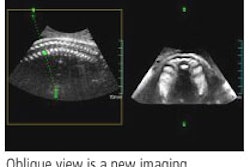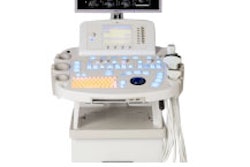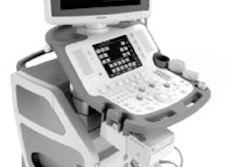Contrast-enhanced color Doppler ultrasound-targeted biopsy offers improvements in prostate cancer detection compared with grayscale ultrasound-guided systematic biopsy cores, according to researchers from the University Hospital Innsbruck in Vienna, Austria.
"The overall cancer detection rate is significantly increased by contrast-enhanced color Doppler targeted biopsy compared with systematic biopsy," said Dr. Leo Pallwein, who presented his team's research at the 2005 RSNA meeting in Chicago.
The Austrian researchers performed a prospective randomized trial comparing five or fewer contrast-enhanced color Doppler ultrasound-targeted biopsy cores to 10 grayscale ultrasound-guided systematic biopsy cores. One hundred consecutive men between January 2004 and June 2004 with elevated prostate-specific antigen levels (PSA ≥ 1.25 ng/mL and free-to-total PSA < 18%) were prospectively randomized to receive either contrast-enhanced targeted or systematic biopsy. Patients ranged in age between 44 and 76, with an average age of 54.
Using a Sequoia ultrasound scanner (Siemens Medical Solutions, Malvern, PA), contrast-enhanced targeted biopsies were performed into hypervascular areas of the peripheral zone during administration of the SonoVue ultrasound contrast agent (Bracco, Milan, Italy).
The researchers subjectively graded vascularity, with 0 representing no color signal, 1 low density, 2 medium density, and 3 high density of color signals; the transit time after bolus administration of the contrast agent was also assessed.
The 10 systematic biopsies were obtained in a standard spatial distribution, and cancer detection rates were compared between the two groups.
The targeted biopsy approach yielded a cancer detection rate of 32% (16/50 patients), significantly better (p < 0.04) than the 26% rate (13/50 patients) produced by the systematic biopsy approach, Pallwein said.
The researchers also discovered that the detection rate for targeted biopsy cores (15.6% or 39/250 cores) was significantly better (p < 0.001) than the 6.8% rate (34/500 cores) for systematic biopsy cores. The mean Gleason score in the 16 patients diagnosed by contrast-enhanced targeted biopsy varied between 6 and 10, while the Gleason score in the 13 patients diagnosed by systematic biopsy varied between 4 and 90, he said.
"Cancerous tissue demonstrated an earlier and higher peak enhancement after microbubble injection compared with benign tissue," Pallwein said.
By Erik L. Ridley
AuntMinnie.com staff writer
December 19, 2005
Related Reading
Guide aims to help men understand prostate cancer, September 12, 2005
Risk factors for prostate cancer mortality after biochemical recurrence identified, July 27, 2005
Urologist promotes brachytherapy for prostate cancer, May 3, 2005
Ultrasound-guided pancreatic biopsy yields effective results, June 22, 2005
Contrast ultrasound shows potential for prostate cancer detection, October 24, 2003
Copyright © 2005 AuntMinnie.com



















